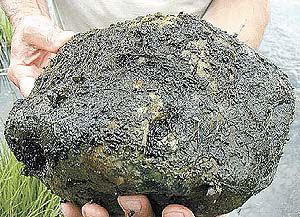| New Zealand mud snails covering a rock. |
The Loa State Fish Hatchery is under temporary quarantine, the Division of Wildlife Resources announced Dec. 3.
The DWR placed the hatchery under quarantine after biologists discovered snails in some of the hatchery’s raceways. (Raceways are areas where fish are raised after they’re hatched from eggs.)
After examining the snails closely, DWR biologists have confirmed that the snails are New Zealand mud snails. Now they’re reviewing options on how to best deal with this aquatic nuisance species in the hatchery.
The Loa hatchery is in the town of Loa, about 40 miles southeast of Richfield. Most of the trout the hatchery raises are placed in waters in southern Utah.
“We’re not sure how New Zealand mud snails got into the hatchery,” says Walt Donaldson, Aquatic Section chief for the DWR. “We won’t increase trout numbers at the hatchery until we can ensure that the water coming into the hatchery is free of snails.”
Donaldson says at this time, the DWR is not planning on killing the trout that are already in the hatchery. “We’re hopeful we can find a way to treat the fish,” he says. “If we can successfully treat the fish, we can place them in waters for anglers to catch this spring.”
Donaldson says several treatment methods are available. “Fish pathologists at our Fisheries Experiment Station in Logan are evaluating those options now,” he says.
New Zealand mud snails are just one of several aquatic nuisance species (ANS) that have made their way into Utah.
The New Zealand mud snails that are found in Utah are female and reproduce asexually. Because they’re asexual, only one snail is required to establish a new colony. One snail can reproduce hundreds of young per year. And they’re very effective at colonizing new waters.
ANS are nasty plants and animals. In other states, they’ve already ruined fishing and affected boating and recreational activities in waters they’ve infested.
But there’s good news: there are several things you can do to avoid bringing ANS into Utah from outside the state, and to avoid transporting it from one body of water in Utah to another.
Disinfecting your waders and other fishing gear — before you step into a different body of water — is one of the best things you can do.
Also, if you’re fishing on a river or stream, disinfect your waders and gear before moving to a different stretch of the same river to fish.
To learn more about ANS including tips on how to avoid spreading them, please visit www.wildlife.utah.gov/habitat/ans.

